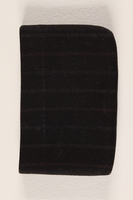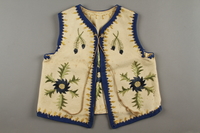Overview
- Description
- The Sara Boucart papers include letters from Sara’s mother written in Saint-Gilles prison in Brussels and a photograph and devotional cards documenting Sara’s time in hiding in the Soeurs de Sainte Marie convent in Wezembeek-Oppem.
- Date
-
inclusive:
1942-1944
- Credit Line
- United States Holocaust Memorial Museum Collection, Gift of Sara Lamhaut Boucart
- Collection Creator
- Sara Lamhaut Boucart
- Biography
-
Sara Liba Lamhaut (later Boucart, b. 1931) was born to Icek Leib (1901-1943?) and Chana Laja (nee Goldwasser, 1905-1942?) Lamhaut. Icek was born in Krasnik, Poland. While he was still a boy, Icek’s parents and younger sister were killed in pogroms and his younger brother, Chaim (later Herman Lambert), immigrated to the United States with an uncle. Icek wanted to follow them to the United States, and he was hired on a merchant marine ship sailing from Germany to New York City. However, he was unable to locate his brother and uncle. Icek landed in Antwerp, Belgium, and worked in the Charleroi mines to obtain a residence permit. After two years, Icek moved to Brussels in 1920. Chana was born in Lodz, Poland, to David and Rykla (nee Pidra, 1884-?). She had two younger sisters, Esther (later Lederman, 1907-?) and Maria (later Bulwa, 1909-?). David and Rykla worked as traveling textile merchants. Around 1913, David died, and Chana dropped out of school to help her mother. Chana moved to Brussels in 1922, and was hired as a governess for a Jewish family with a shoe business. Esther and Maria both escaped from Poland to Paris with their families, but were killed during the Holocaust. Chana’s mother, Rikla Goldwasser, continued to live in Lodz.
Icek and Chana met and married in Brussels on December 6, 1930. Icek had a tailoring business while Chana largely took care of the household, and assisted with the business on occasion. Their daughter, Sara, was born the following year. To avoid the risk of deportation, the family moved often between the commune of Saint-Gilles, Brussels, and Anderlecht. The family spoke Yiddish, Polish, and German at home, and at five years old, Sara began learning French at a small Jewish nursery school.
Belgium was invaded by Germany in May 1940, and the occupying administration quickly enacted anti-Jewish laws and policies that restricted civil rights and confiscated property. Chana and Icek took part in resistance activities. They bought a small printing machine, and began printing newspapers for Jews in their small apartment. In May 1942, Sara and the other Jewish children were prohibited from the public school, and transferred to a Jewish school. Although they were under the mandate to wear a Star of David badge, Sara refused to do so, at risk of severe punishment.
On May 26, Chana and Icek were taken into custody by gestapo and SS officers. Icek was released a few hours later, but Chana was arrested and imprisoned for six months in the Saint Gilles prison. While there, she was tortured, but was able to send a couple letters to Icek and Sara. Chana was then sent to a transit camp which had been converted from the Dossin de St. Georges military barracks in the city of Mechelen (also known as Malines). In the summer of 1942, German authorities began collecting Jews in the Breendonk and Mechelen transit camps, before deporting them to Auschwitz. Chana was deported on October 24, 1942 aboard transport XIV, and arrived two days later at Auschwitz-Birkenau killing center, where she was killed.
Icek decided to continue his work with the resistance and joined l’Armée Belge des Partisans (the Belgian Army of Partisans). In September 1942, he placed Sara in the care of Andrée Geulen, a member of the Comité de Défense Juive (CDJ, Jewish Defense Committee). The CDJ formed in the summer of 1942 and played a critical role in resistance activities and hiding children. After a few months in a private home, Sara and three other Jewish children were hidden in a convent near Mons. To protect the hidden children, they often went under assumed names, and only the heads of the convents knew their identities. While in hiding, Sara went by the name of Jeannine van Meerhaegen. In the winter, she was moved to a chateau in Arlon in Belgian Luxembourg. After about a month, Sara left in search of her father, who she stayed with until May 1943, when Sara was hidden in another convent. In July 1943, Icek returned to Brussels from an arms delivery, and was arrested by the German authorities. He was deported on July 31, 1943 from the transit camp at Mechelen aboard transport XXI to Auschwitz-Birkenau, where he was killed. In September, an instructor at the convent became suspicious that Sara was living under a false name, and she had to leave. She was placed in the Soeurs de Sainte Marie convent in Wezembeek-Oppem. While there, she received her First Communion and a Certificate of Confirmation on May 8, 1944, which helped fortify her false, Christian identity. She remained there until Belgium was liberated in September 1944.
After liberation, Sara spent seven months at the Convent of Saint-Pierre. She ran into the daughter of Francois Debaene, a non-Jew who had been a friend of her parents. Francois invited Sara into their home, against his wife’s objections. Sara stayed with them for seven years. At 16, she applied and completed the exam to become a Belgian citizen. Sara enrolled in secretarial school, and went on to have a 47-year long career. In 1955, she married Leo Boucart, a parachutist, and later had one daughter.
Physical Details
- Genre/Form
- Letters. Photographs.
- Extent
-
1 folder
- System of Arrangement
- The Sara Boucart papers are arranged in a single folder.
Rights & Restrictions
- Conditions on Access
- There are no known restrictions on access to this material.
- Conditions on Use
- The donor, source institution, or a third party has asserted copyright over some or all of the material(s) in this collection. You do not require further permission from the Museum to use this material. The user is solely responsible for making a determination as to if and how the material may be used.
Keywords & Subjects
- Geographic Name
- Brussels (Belgium) Wezembeek-Oppem (Belgium)
Administrative Notes
- Holder of Originals
-
United States Holocaust Memorial Museum
- Legal Status
- Permanent Collection
- Provenance
- Sara Lamhaut Boucart donated the Sara Boucart papers to the United States Holocaust Memorial Museum in 1997 and 2019.
- Primary Number
- 1997.63.29
- Record last modified:
- 2023-04-04 15:20:14
- This page:
- https://collections.ushmm.org/search/catalog/irn740781
Download & Licensing
In-Person Research
- Available for Research
- Plan a Research Visit
-
Request in Shapell Center Reading Room
Bowie, MD
Contact Us
Also in Sara Lamhaut Boucart collection
The collection consists of a handmade vest and correspondence relating to the experiences of Sara Lamhaut, Chana Goldwasser Lamhaut, and Riiha Goldwasser in Łódź, Poland, and Brussels, Belgium, during the Holocaust.
Date: 1942-1944

Bible received by a Jewish girl while in hiding at a Catholic school
Object
Bible and cover given to Sara Lamhaut in December 1943 as part of her confirmation while in hiding at a convent school in Wezembeek-Oppem, Belgium. Sara was born in Brussels in 1931, to Polish parents, Icek and Chana Lamhaut. After Belgium was invaded by Germany in May 1940, Chana and Icek began participating in resistance activities, including covertly printing Jewish newspapers in their apartment. On May 26, 1942, Chana and Icek were taken into custody by gestapo and SS officers. Icek was released, but Chana was imprisoned and tortured for six months in the Saint Gilles prison. She was then sent to the Mechelen (also known as Malines) transit camp, and deported on October 24, 1942, to Auschwitz-Birkenau killing center in German-occupied Poland, where she was killed. Icek then joined l’Armée Belge des Partisans (the Belgian Army of Partisans). In September 1942, he placed Sara in the care of Andrée Geulen, a member of the Comité de Défense Juive (CDJ, Jewish Defense Committee). Sara was hidden as a Catholic in a series of convent schools near Brussels, under the assumed name of Jeannine van Meerhaegen. In July 1943, Icek was arrested by the German authorities and was deported from Mechelen to Auschwitz-Birkenau, where he was killed. After Belgium was liberated by Allied forces in September 1944, she was taken in by a non-Jewish friend of her parents for seven years. At 16, Sara passed her citizenship exam and officially became a Belgian citizen.

Hand-embroidered child's vest made by a Polish Jewish woman
Object
Hand-embroidered child’s vest sent to Sara Lamhaut in Brussels, Belgium, by her grandmother, Rykla Goldwasser, in Łódź, Poland. Sara was born in Brussels in 1931, to Polish parents, Icek and Chana Lamhaut. After Belgium was invaded by Germany in May 1940, Chana and Icek began participating in resistance activities, including covertly printing Jewish newspapers in their apartment. On May 26, 1942, Chana and Icek were taken into custody by gestapo and SS officers. Icek was released, but Chana was imprisoned and tortured for six months in the Saint Gilles prison. She was then sent to the Mechelen (also known as Malines) transit camp, and deported on October 24, 1942, to Auschwitz-Birkenau killing center in German-occupied Poland, where she was killed. Icek then joined l’Armée Belge des Partisans (the Belgian Army of Partisans). In September 1942, he placed Sara in the care of Andrée Geulen, a member of the Comité de Défense Juive (CDJ, Jewish Defense Committee). Sara was hidden as a Catholic in a series of convent schools near Brussels, under the assumed name of Jeannine van Meerhaegen. In July 1943, Icek was arrested by the German authorities and was deported from Mechelen to Auschwitz-Birkenau, where he was killed. After Belgium was liberated by Allied forces in September 1944, she was taken in by a non-Jewish friend of her parents for seven years. At 16, Sara passed her citizenship exam and officially became a Belgian citizen. Rykla likely died in the Łódź Ghetto during the Holocaust.



